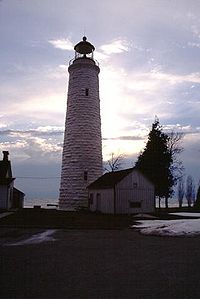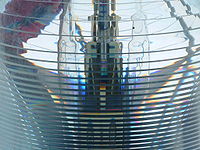
Imperial Towers
Encyclopedia

Lighthouse
A lighthouse is a tower, building, or other type of structure designed to emit light from a system of lamps and lenses or, in older times, from a fire, and used as an aid to navigation for maritime pilots at sea or on inland waterways....
s built on Lake Huron
Lake Huron
Lake Huron is one of the five Great Lakes of North America. Hydrologically, it comprises the larger portion of Lake Michigan-Huron. It is bounded on the east by the Canadian province of Ontario and on the west by the state of Michigan in the United States...
by the Canadian
Canada
Canada is a North American country consisting of ten provinces and three territories. Located in the northern part of the continent, it extends from the Atlantic Ocean in the east to the Pacific Ocean in the west, and northward into the Arctic Ocean...
government. The designation Imperial is not certain, but historians speculate that because the towers were public construction built under United Kingdom
United Kingdom
The United Kingdom of Great Britain and Northern IrelandIn the United Kingdom and Dependencies, other languages have been officially recognised as legitimate autochthonous languages under the European Charter for Regional or Minority Languages...
authority, the name would assure funding from the British Empire
British Empire
The British Empire comprised the dominions, colonies, protectorates, mandates and other territories ruled or administered by the United Kingdom. It originated with the overseas colonies and trading posts established by England in the late 16th and early 17th centuries. At its height, it was the...
's Board of Trade. (Sapulski, Crompton).
History
In 1855 the Board of Works contracted with John BrownJohn Brown (builder)
John Brown was a Canadian builder of Scottish origin. He is best remembered today for building Ontario's Imperial Towers.Brown began his career as a stonemason's apprentice in Glasgow. At 23 he emigrated to the United States, to upstate New York...
, a builder from Thorold, Ontario
Thorold, Ontario
Thorold is a city in Ontario, Canada, located on the Niagara Escarpment. It is also the seat of the Regional Municipality of Niagara....
, to build eleven lighthouses and dwellings lighting Lake Huron
Lake Huron
Lake Huron is one of the five Great Lakes of North America. Hydrologically, it comprises the larger portion of Lake Michigan-Huron. It is bounded on the east by the Canadian province of Ontario and on the west by the state of Michigan in the United States...
and Georgian Bay
Georgian Bay
Georgian Bay is a large bay of Lake Huron, located entirely within Ontario, Canada...
between Point Clark
Point Clark, Ontario
Point Clark is a lakefront town on Lake Huron, in Canada. It is approximately 20 kilometers south of Kincardine and 35 kilometers north of Goderich. Main streets include Huron Road and Lake Range Road. Point Clark is served by Highway 21 . It is a cottage town, and has a rare Imperial Tower style...
and Christian Bay
Christian Island, Ontario
Christian Island is a large island in Georgian Bay close to the communities of Penetanguishene and Midland, Ontario. The island, with its neighbors Hope Island and Beckwith Island, is a Ojibwa reserve, known as Christian Island 30 Indian Reserve...
. In the event, only six of the towers were completed. These were:
- Point Clark Lighthouse 44.07281°N 81.75731°W
- Chantry Island Light 44.48938°N 81.40194°W
- Cove Island Light 45.32699°N 81.73505°W
- Nottawasaga Island Light 44.53656°N 80.25702°W
- Griffith Island Light 44.85058°N 80.89137°W
- Christian Island Light 44.78664°N 80.15607°W
All six were built between 1855 and 1859; for the most part, their construction was simultaneous. Cove Island was the first to be lit, on October 30, 1858; Christian Island, the first to be completed but the last to be lit, began work on May 1, 1859.
The locations of the towers were chosen based on known traffic patterns; each tower marked a prominent navigation
Navigation
Navigation is the process of monitoring and controlling the movement of a craft or vehicle from one place to another. It is also the term of art used for the specialized knowledge used by navigators to perform navigation tasks...
al hazard which was already well-recognized. Sites were also chosen based on their proximity to good anchorages.
Construction
Construction of the lights was plagued by difficulties. Brown lost four full supply boats, all of which sank before reaching their destinations and unloading. More supplies were lost from being swept overboard during storms and rough seas. Furthermore, delivery of the lighting apparatus for each tower was delayed by competing demand from lighthouse expansion in the United StatesUnited States
The United States of America is a federal constitutional republic comprising fifty states and a federal district...
and a bottleneck in the delivery of the French lenses. Consequently, Brown was facing bankruptcy by 1857, and petitioned the provincial government for assistance. The government responded favorably, and by 1859 all six towers were lit.
Description

Cone (geometry)
A cone is an n-dimensional geometric shape that tapers smoothly from a base to a point called the apex or vertex. Formally, it is the solid figure formed by the locus of all straight line segments that join the apex to the base...
, their interior diameter is 10'6
The towers and dwellings are constructed of limestone
Limestone
Limestone is a sedimentary rock composed largely of the minerals calcite and aragonite, which are different crystal forms of calcium carbonate . Many limestones are composed from skeletal fragments of marine organisms such as coral or foraminifera....
, with granite
Granite
Granite is a common and widely occurring type of intrusive, felsic, igneous rock. Granite usually has a medium- to coarse-grained texture. Occasionally some individual crystals are larger than the groundmass, in which case the texture is known as porphyritic. A granitic rock with a porphyritic...
added to the towers to support the lantern rooms. The lanterns are made of copper
Copper
Copper is a chemical element with the symbol Cu and atomic number 29. It is a ductile metal with very high thermal and electrical conductivity. Pure copper is soft and malleable; an exposed surface has a reddish-orange tarnish...
alloy
Alloy
An alloy is a mixture or metallic solid solution composed of two or more elements. Complete solid solution alloys give single solid phase microstructure, while partial solutions give two or more phases that may or may not be homogeneous in distribution, depending on thermal history...
s, glass
Glass
Glass is an amorphous solid material. Glasses are typically brittle and optically transparent.The most familiar type of glass, used for centuries in windows and drinking vessels, is soda-lime glass, composed of about 75% silica plus Na2O, CaO, and several minor additives...
, and cast iron
Cast iron
Cast iron is derived from pig iron, and while it usually refers to gray iron, it also identifies a large group of ferrous alloys which solidify with a eutectic. The color of a fractured surface can be used to identify an alloy. White cast iron is named after its white surface when fractured, due...
.
The towers are whitewash
Whitewash
Whitewash, or calcimine, kalsomine, calsomine, or lime paint is a very low-cost type of paint made from slaked lime and chalk . Various other additives are also used...
ed and painted with red trim. Each was initially equipped with a Fresnel lens
Fresnel lens
A Fresnel lens is a type of lens originally developed by French physicist Augustin-Jean Fresnel for lighthouses.The design allows the construction of lenses of large aperture and short focal length without the mass and volume of material that would be required by a lens of conventional design...
; they were the first Canadian lighthouses so equipped.
, all six towers are still standing.
Sources
- Sapulski, W.; The Imperial Towers of Lake Huron and Georgian Bay
- Berger, T. & Dempster, D.; Lighthouses of the Great Lakes; Voyageur 2002
- Crompton, W. & Rhein, M. The Ultimate Book of Lighthouses; Thunder Bay 2003
- Weaver, H.; John Brown's Imperial Towers: End of an Era; Inland Sea; 1992

